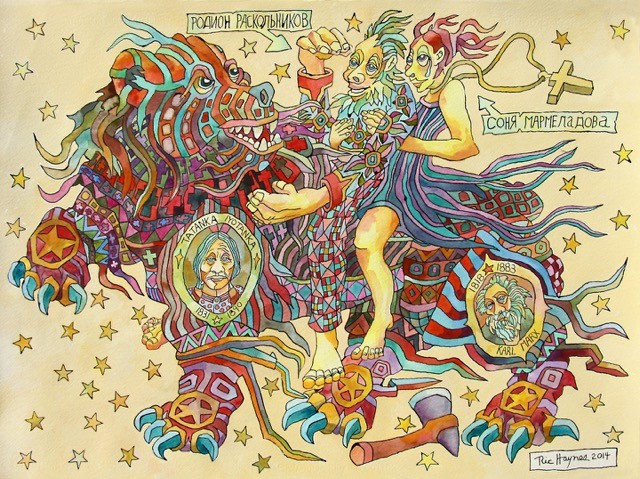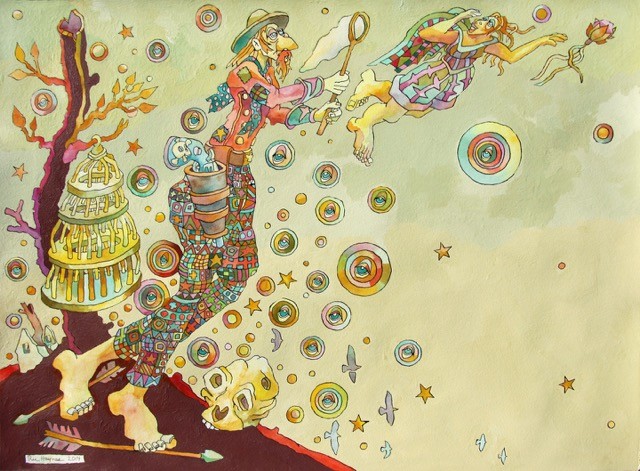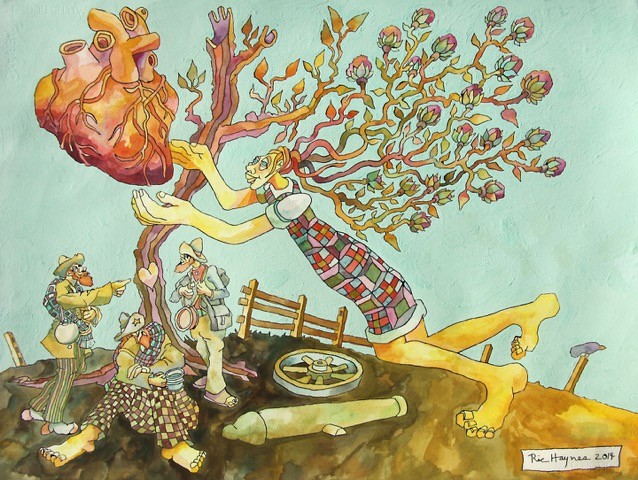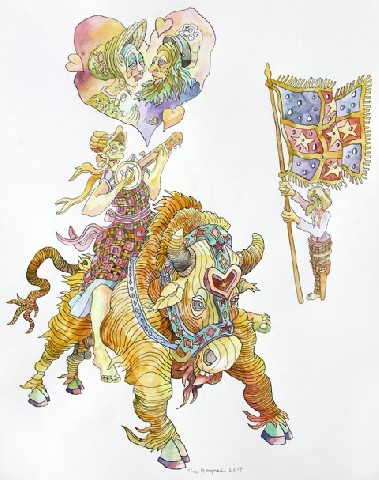Ric Haynes Vision Quest
Upcoming Show at Boston's HallSpace Gallery
By: Charles Giuliano - Feb 02, 2015
During a Suffolk University sponsored Spring Break tour of Spain I met Ric and Lorraine Haynes. He took along a sketch book and captured impressions. We talked a lot about the art and culture we were experiencing which continued during a later tour of Italy.
He was then showing with Creiger Dane Gallery on Newbury Street. I have followed his ever evolving work through a number of exhibitions. While it morphs and changes there is also an identifiable consistency.
Like snakes, from infancy, each year we shed our skin. It is that outer layer of self visible to the world. Many factors of responses to challenge and adversity modify our appearance and personality. We examine ourselves in a mirror and gaze with wonder at pictures in albums.
Who is that stranger staring back at me? While deep inside remaining the child who, from an early age, committed to a life in art. In the case of Haynes creating work that is more about self discovery, mythology and tribalism than fashion and careerism.
Pursing a path less taken allows Haynes to delve deeply into the forest in a vision quest that is spiritual, often hilarious, private and personal.
Charles Giuliano I have followed your work over a number of years. Some time ago we worked together on an exhibition of your books for the New England School of Art & Design at Suffolk University. Recently you sent images of work you will soon be showing Where Am I, March 21 to April 25, at HallSpace (950 Dorchester Avenue Boston, MA 02125). How has the work changed?
Ric Haynes In 2012 I had a show of very large works in oil paint. They were mostly 4 x 7'. They were done in a traditional style derived from French impressionism and Bay Area figure painting. I realized it was wrong for me and draining me of my vision. I took a residence in Wyoming. That fall I began to reconstruct something which was more in my nature with watercolor and ink. I had always been fascinated by Ben Shahn's work and I loved his immediacy with those materials.
I got to spend some time with him in 1967 at Skowhegan in Maine. He died in 1968. Skowhegan was wonderful in many ways. I encountered people who were speaking an art talk that I had never heard before.
(Skowhegan School of Painting and Sculpture is a nine week summer residence program for emerging artists.)
I was with interesting artists and critics. Tony Smith (father of Kiki Smith) was one of them. The sculptor Peter Agostini was there. Walter Murch was the artist I was most attached to. He was in residence for the nine weeks. Other artists came and went. The way we talked is the way I'm thinking now.
He was connected to Fulbright and other grants. I said to him that I would like to go to Germany to study expressionism. He laughed at me and said "No, you're really better off in Brazil." Some 40 years later I come to understand what he meant as I'm a very transcultural kind of person. I'm interested in indigenous cultures and different processes.
My interests are really very different from the mainstream art world. I really like the Baseball Hall of Fame in Cooperstown.
When I was in Wyoming I ran into another artist who asked if I had ever done one of these (residences) before and I said "Yeah, Skowhegan." He said "Who was there during your residence" and I answered Ben Shahn. He responded "Oh, he's a has been."
When I get those kind of remarks I think, wow, I must have struck gold. I think I'm the only one who has read his book. What's it called?
CG "The Shape of Content."
RH I love that book because it's a lot about what I've done. From bussing tables to making art.
When I looked at my paintings in 2012 I realized I wasn't true to myself. . During the residence I had no oil paint. I had watercolors, a flat table, and fantastic views. I was on a 28,000 acre ranch and there was nothing to disturb my head. I was in an empty room and they gave you a sandwich at noon. They left it outside your door. It was like being in solitary confinement.
What came out of it was a combination of mythology and Indian motifs as well as old people. I'm into age in my work. I left the Colonial French stuff. I'm no longer into Colonialism and all the problems people talk about in art. I was talking to a friend about Hinduism and he said "Welcome to the club." So I'm kind of in another club. That club is about dancing with a bear skin.
CG In what sense are you using French Colonialism?
RH It's about how people went into the world and colonized things. It's a large part of Post Modernism. I come from that world. My heritage is very much mixed into that. I've got the Indian world and the Colonial world and all this kind of stuff.
(For many years Haynes has had a close relationship with Native American culture.)
I'm going back into it saying I come from Pennsylvania Germans. Hex medicine. It's an old folklore medicine. I got into quilt patterning and all these things with pants and clothing. Older ideologies. It's kind of like medieval more than modern work. I wouldn't say I'm modern anymore. I'm falling backward in time.
When I look at work by an artist like (Christian) Boltanski I understand his language about the Holocaust. (Born 1944 Boltanski is a French sculptor, photographer, painter and film maker.) With the clothing and piling of objects. I understand it but I'm doing something else which is detailed.
I'm doing a piece right now about artillerists. I was an artillerist in Vietnam.
CG You have talked about firing into the jungle and watching the explosions.
RH I see things differently and how to put it into the art. I'm seeing things and experiences I've had in other places. I'm at the point in my life where I'm almost embarrassed that I went to art school. I think I would have done better in a literature program. Perhaps anthropology or those investigative kinds of things. Not science but different kinds of philosophies.
CG What you describe is a process of both exploration and marginalization.
RH Perfect.
CG You put yourself out of the loop with self imposed marginalization for example a medievalist in an age of post modernism. It's remarkable that anyone wants to show your work or write critical essays about it. As you say you're going back in time. So there is no careerism in having anything to do with you professionally. You're a pariah. You belong in a leper's colony on a remote island in the Pacific.
RH Thank you. (laughing) That's the highest possible compliment.
CG You belong on an island attended to by a priest whose nose fell off years ago.
RH Thank you. That's great. Exactly.
CG In your work is this a process of discovery of self destruction?
RH A little bit of both but more in self discovery because I'm happier. The work has a lot of sense of humor. There's cartooning and that kind of world. I get more out of literature and cartooning than in taking an anatomy class. Recently I took an anatomy class and it was tortuous. The first thing he did was show a picture by Vermeer and said you should paint like this. The self destructive part is that I don't have many friends in the art world. It's shallow.
CG You don't deserve to have any.
RH Thank you. (both laughing) Thank God I was on that bus with you in Spain.
CG At mid life you changed from one career to another. You ended a practice as an expressive art therapist and went back to get an MFA degree. The purpose was to qualify to pursue a tenure track teaching position.
RH I'm actually officially retiring from teaching this year.
CG What value did you get from a graduate program? Were you just punching the clock to get credentials? Or were there challenges and learning experiences?
RH Part of that is true. I wanted to end working as a therapist and in order to advance in teaching I needed a degree. But the reading at Vermont College was very powerful. I had teachers who knew my interests and were pointing to insightful material. A British woman, Martha Fleming, brought me into the contemporary world of people being influenced by the Mayans and Aztecs. It was wild. I did a semester of humor from the medieval world to the Holocaust. I did a lot of work on Buster Keaton. A lot of it was working with marginality. One of the books was "On the Edge." It discussed medieval manuscripts and how they did provocative drawings in the margins.
It took me nine years to get out of graduate school. I thought about what am I actually going to make. When I had my last show at HallSpace I was making David Park/ Elmer Bischoff kinds of things but I wasn't delving into the kind of ink and watercolor things I was doing when I was fifteen. It's a thing about passion and desire. Being an artist.
There's a lot of people in the art world who are like lining up lipstick from dark shades to the light shaded and they're happy with that. I don't even know what that is. They talk about it in terms of consumerism but screw that. I don't know what that means.
CG Are you referring to James Rosenquist?
RH No Andrea Zittel and those kinds of people. She's a famous arranger of towels and stuff. Rosenquist is more romantic than a lot of these newer people.
CG Talk to me about HallSpace. What is its agenda and who runs it?
RH The director is John Colans. He shows a lot of elder artists by which I mean people past fifty. He shows younger people as well. He takes a lot of risk by showing people who are unconventional. He did a show in the fall in which he covered the walls of the gallery with drawing paper. He divided it into 280, 12" squares. The public was invited in to fill the boxes and all kinds of people participated. He sold the drawings for $50.
He does a lot of non traditional, non-gallerist kinds of things. He supports people with a lot of battle scars.
CG He sounds like he has more the approach of an artist than that of a gallerist.
RH He's a great story teller. We bring him cookies all year long.
CG Through your training as a therapist you studied and were influenced in your works by dreams, the subconscious, and the theories of Freud and Jung. That foundation then conflated with interests in mythology, particularly Native American culture. How important was the study of Jung in the development of narrative content in your work?
RH Very little actually. Right now I don't have a lot to do with Jung.
CG I'm focusing more on the role of Jung as a source and origin of the dialogue in your work. Was he the progenitor?
RH Yes. Definitely. I read all of Jung in the 1970s and I knew a number of Jungian therapists. As I got older I moved to the existential. Jung brought me into mythology. I read Paul Radin and his essay on "The Trickster: Memories, Dreams, Reflections by Jung" is the greatest book on Jung. You get the whole map of his literature. I don't like his idea of universality. It's an interesting idea but head hunters in Fiji are very different from head hunters in New Guinea. They don't do it for the same reason.,
CG To say nothing of head hunters on Wall Street.
RH Exactly. That's important to put in there. Native Americans believe in more than one god and often very funny and interesting gods. Like Old Man Coyote. They take advice from him. They are also very accepting of Luteranism and Mormanism. They just want to find out if anything works. Lorraine and I are currently working with monks and priests in a Thai temple just down the street from us. People say to us "Are you going to be a Buddhist?" Are you kidding me? It's as complicated as Roman Catholicism. Jung brought me into this world but I don't worship the man.
CG Looking at the recent water colors and their narratives who are these people and what are they about?
RH There's one of a woman chasing her heart. The idea came from a student who talked with me about hunting for her own heart so she could share it with other people. I use a lot of characters from the Civil War because they are more interesting to me than Vietnam. The hearts are the ones who were left behind. The sweethearts. There's a lot of that.
There's another one of a man carrying a woman with a pistol. There are vines growing out of her feet. This came from going to a library lecture about the biography and archaeology of Bonnie and Clyde. Clyde had an accident while being chased down a road which resulted in splashing battery acid on Bonnie. Her legs were severely damaged. She couldn't walk after that so he carried her everywhere. What a romantic image of him carrying her into banks when they did robberies. She became a mythological creature. She's no longer part of this world.
CG What are the mythologies of the works for the show?
RH One of them has a bear which comes from "Crime and Punishment." I found a Russian woman who was teaching an eight week course on the book. It was the most amazing course I have ever taken. She hit all the stops of that literature. (Rodion Romanovich) Raskolnikov is told stop thinking of going to Siberia. Go to America. That triggered the idea that Sonia and Raskolnikov get on a big bear and go to America.
There's images of Karl Marx and Sitting Bull. Karl Marx is kind of an image for Native Americans living together communally.
Another one depicts an Indian pointing to a jar which has a strange creature in it. Indians like to drive around in Hummers because they are making so much money through casinos. So here's this very romantic Indian with old sunglasses on. He used to be the oddity but he's pointing into a jar and something else is creeping up. That piece is called Curiosity. It is also about marginality.
I get high talking to you.
CG We don't get many opportunities to talk about our work with someone who knows and cares.
RH I grew up in Pennsylvania in York not far from Dover which is where Jeff Koons grew up. You don't get any hickier than that. We are so different and I just love that.
CG In a climate of benign neglect, particularly compared to Koons, what motivates you to continue to make work?
RH I am determined to make work to show my humanity to humanity. I always want to be human. Covered in pencil dust. Children love my work because it has that thing that children do. I travel and read. I experience things like the Goya show at the MFA. There's a lot of stuff and I love stuff. I can go to a baseball game and think of every player as a big bear and make a drawing out of that.
CG How much time do you get in the studio.
RH A lot but not every day. Today I'm going to the temple to help a girl with language stuff. Super markets are my other favorite museums. I get to talk to the cashiers.
CG It's great to catch up on your work.






